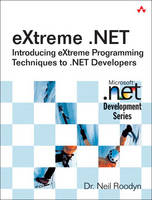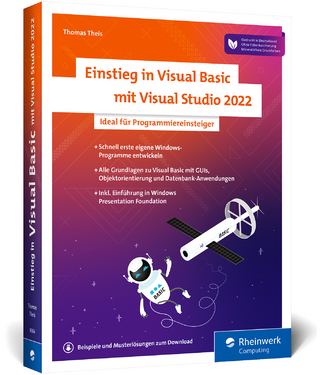
eXtreme .NET
Addison-Wesley Educational Publishers Inc (Verlag)
978-0-321-30363-9 (ISBN)
- Titel ist leider vergriffen;
keine Neuauflage - Artikel merken
In a major shift from the past, Microsoft has been encouraging developers who
use Visual Studio to pay attention to software architecture and software
development methodologies. One methodology which is well-suited to the way
that many Microsoft development teams work is eXtreme Programming. Many
developers using VB and C# admire its flexibility, its emphasis on testing, and
the idea of developing in small teams. While they have been trying to pick up
the XP techniques from the general books on XP and Agile, there is a dearth of
information to help them apply the Agile techniques in a Microsoft setting.
Extreme .NET
is the first book to provide a complete and practical guide to
using eXtreme Programming with .NET. The author is well regarded in both
the XP and .NET communities. He uses extensive case studies and real world
examples to illustrate best practices throughout the book, and provides many
hands-on exercises so that readers make sure they have learned the concepts.
The book concludes with a chapter on step-by-step development that will put
together all the practices taught in the book to develop a piece of software.
Foreword. 0. Setup. 1. eXtreme Programming Overview. What Is eXtreme Programming? Working in The Ever-Faster-Changing World. The Answers According to Microsoft. The Answers According to XP. How .NET and XP Fit Together. You Don't Have to "Believe" in XP to Learn Something from It. The Roles. What .NET Developers Can Gain from XP Practices. XP Practices Covered in This Book. Whole Team (a.k.a. On-Site Customer). Planning Game. Pair Programming. Test-Driven Development. Constant Refactoring. Spiking. Continuous Integration. Stand-Up Meetings. The Other Practices. The 4 (+ 1) Key Values. Communication. Simplicity. Feedback. Courage. Respect. Conclusion. 2. Pair Programming. I'm Not Sitting with Him! The Professional Attitude. Get With the Winning Approach. It's a Game. Exercise 2-1: Game to Teach Pair Programming. Exercise 2-2: Step-by-Step Exercise to Get a Feel for Pair Programming. Try It Together. Exercise 2-3: Exercises for Two Developers to Work On Together. Conclusion. 3. How to Solve Big Problems. The Software Development Problem. The Genius Is in the Simplicity. Big, Complex Solutions. The Genius Function. Example of Problem Breakdown. Problem Breakdown Exercise. Exercise 3-1: Defining the Story. Exercise 3-2: Breaking Down the Stories into Small Subtasks. Exercise 3-3: Breaking Down the Subtasks Even Further. Exercises to Help You Toward Genius. Exercise 3-4: The Shopping Cart. Exercise 3-5: Derived Stock Market Data. Exercise 3-6: What's the Weather Like? Exercise 3-7: The Unfinished Solution. Conclusion. 4. Test-Driven Development. Is It Possible to Write Bug-Free Code? Increase the Quality of Your Code. The Big Why. Introducing Nunit. Creating a New Project in C# Using Nunit. Exercise 4-1: Get NUnit Up and Running. Exercise 4-2: Write a Test and Add Some Functionality. Exercise 4-3: Plug the Business Logic into the User Interface. Exercise 4-4: Plug the Business Logic into a Different User Interface. Exercise 4-5: Write a Test to Fix a Bug. Exercise 4-6: Write a Test and Then Add Another Function. Exercise 4-7: Write a Test and Then Extract the Method. Exercise 4-8: Add the UI for Subtraction. Exercise 4-9: Extract Functionality Out of the UI Layer. How Do You Feel About TDD? Exercise 4-10: Without Tests. Exercise 4-11: With Tests. Confidence Test. Conclusion. 5. Refactoring. What Is Refactoring. Do It As You Go. The Importance of Tests. The Benefits. Feedback. Communication. Simplicity. Some More Big "Why" Questions. Why Should I Do It When No One Else Does? Why Do Something That Doesn't Add Any New Features to the Code? Let's Start Refactoring. Exercise 5-1: Currency Converter Refactoring. When Not to Refactor. Conclusion. 6. Spiking. You Can't Know Everything. Raise Your Confidence. Let's Discover Something. Exercise 6-1: Spiking How Time Zone Data Works in Windows. Encode the Knowledge in Tests. Go Where No Man Has Gone Before. Exercise 6-2: Spike Web Services Without a Web Server. Exercise 6-3: Spike Session State Across Service Calls. Exercise 6-4: Spike Drag and Drop Documents in a Rich Text Control. Conclusion. 7. Automating the Build Process. What is the Build Process? What's Wrong with F5? I Make Mistakes. If a Computer Can Do It, Then It Should. Do It the Old Way. Exercise 7-1: Creating an Integration Build Batch File. Introduction to Nant. Exercise 7-2: Using NAnt to Automate the Build Process. Conclusion. 8. More Testing. User-Interface Testing. It's Not Possible! "We Are a Special Case". An Issue of Architecture. Exercise 8-1: Building a Thin GUI Layer to Make Testing Easier. Stamper Part Two. Stamper Part Three. Exercise 8-2: Using Reflection to Test the GUI. Exercises on Your Own. Testing Third-Party Libraries. We All Do It. The .NET Framework Is a Third-Party Library! Component-Based Software Development Is Here. If It Goes Wrong, We're All in the Brown Stuff. Put the Alarms in Place. Step-by-Step Exercises Using a Third-Party Library. Exercise 8-5: Setting Up NUnit (Again!). Exercise 8-6: The Quick Breadth Test. Exercise 8-7: The Functional Depth Test. Exercise 8-8: Testing for Exceptions. Exercise 8-9: Examining the Code. Exercise 8-10: Writing a Breadth Test. Exercise 8-11: Getting the Breadth Test Running. Exercise 8-12: Writing a Test to Break the Code. Exercise 8-13: Forcing an Intermittent Error. Coding with Protection. Exercise 8-14: Protecting Yourself Against the Change. Exercise 8-15: Plugging In the New Changed Library. Conclusion. 9. Step-by-Step Development. Step by Step by Step. A Strategy to Lower the Risk of Failure. Step-by-Step Exercise to Demonstrate the Small-Step Approach. Conclusion. Appendix I. Guideline Solutions for Task Breakdown Exercises in Chapter 3. Exercise 3-4: The Shopping Cart. Exercise 3-5: Derived Stock Market Data. Exercise 3-6: What's the Weather Like? Exercise 3-7: The Unfinished Solution. Appendix II. Building Your Own Simple Test Framework with Excel Appendix III. Recommended Reading. Important Books for Software Developers Working in Teams. XP-Specific Books. XP-Specific Web Sites. Agile Techniques Books. Agile Web Sites. Agile Tools Web Sites. A Book About Change. Index.
Foreword.
0. Setup.
1. eXtreme Programming Overview.
What Is eXtreme Programming?
Working in The Ever-Faster-Changing World.
The Answers According to Microsoft.
The Answers According to XP.
How .NET and XP Fit Together.
You Don't Have to "Believe" in XP to Learn Something from It.
The Roles.
What .NET Developers Can Gain from XP Practices.
XP Practices Covered in This Book.
Whole Team (a.k.a. On-Site Customer).
Planning Game.
Pair Programming.
Test-Driven Development.
Constant Refactoring.
Spiking.
Continuous Integration.
Stand-Up Meetings.
The Other Practices.
The 4 (+ 1) Key Values.
Communication.
Simplicity.
Feedback.
Courage.
Respect.
Conclusion.
2. Pair Programming.
I'm Not Sitting with Him!
The Professional Attitude.
Get With the Winning Approach.
It's a Game.
Exercise 2-1: Game to Teach Pair Programming.
Exercise 2-2: Step-by-Step Exercise to Get a Feel for Pair Programming.
Try It Together.
Exercise 2-3: Exercises for Two Developers to Work On Together.
Conclusion.
3. How to Solve Big Problems.
The Software Development Problem.
The Genius Is in the Simplicity.
Big, Complex Solutions.
The Genius Function.
Example of Problem Breakdown.
Problem Breakdown Exercise.
Exercise 3-1: Defining the Story.
Exercise 3-2: Breaking Down the Stories into Small Subtasks.
Exercise 3-3: Breaking Down the Subtasks Even Further.
Exercises to Help You Toward Genius.
Exercise 3-4: The Shopping Cart.
Exercise 3-5: Derived Stock Market Data.
Exercise 3-6: What's the Weather Like?
Exercise 3-7: The Unfinished Solution.
Conclusion.
4. Test-Driven Development.
Is It Possible to Write Bug-Free Code?
Increase the Quality of Your Code.
The Big Why.
Introducing Nunit.
Creating a New Project in C# Using Nunit.
Exercise 4-1: Get NUnit Up and Running.
Exercise 4-2: Write a Test and Add Some Functionality.
Exercise 4-3: Plug the Business Logic into the User Interface.
Exercise 4-4: Plug the Business Logic into a Different User Interface.
Exercise 4-5: Write a Test to Fix a Bug.
Exercise 4-6: Write a Test and Then Add Another Function.
Exercise 4-7: Write a Test and Then Extract the Method.
Exercise 4-8: Add the UI for Subtraction.
Exercise 4-9: Extract Functionality Out of the UI Layer.
How Do You Feel About TDD?
Exercise 4-10: Without Tests.
Exercise 4-11: With Tests.
Confidence Test.
Conclusion.
5. Refactoring.
What Is Refactoring.
Do It As You Go.
The Importance of Tests.
The Benefits.
Feedback.
Communication.
Simplicity.
Some More Big "Why" Questions.
Why Should I Do It When No One Else Does?
Why Do Something That Doesn't Add Any New Features to the Code?
Let's Start Refactoring.
Exercise 5-1: Currency Converter Refactoring.
When Not to Refactor.
Conclusion.
6. Spiking.
You Can't Know Everything.
Raise Your Confidence.
Let's Discover Something.
Exercise 6-1: Spiking How Time Zone Data Works in Windows.
Encode the Knowledge in Tests.
Go Where No Man Has Gone Before.
Exercise 6-2: Spike Web Services Without a Web Server.
Exercise 6-3: Spike Session State Across Service Calls.
Exercise 6-4: Spike Drag and Drop Documents in a Rich Text Control.
Conclusion.
7. Automating the Build Process.
What is the Build Process?
What's Wrong with F5?
I Make Mistakes.
If a Computer Can Do It, Then It Should.
Do It the Old Way.
Exercise 7-1: Creating an Integration Build Batch File.
Introduction to Nant.
Exercise 7-2: Using NAnt to Automate the Build Process.
Conclusion.
8. More Testing.
User-Interface Testing.
It's Not Possible!
"We Are a Special Case".
An Issue of Architecture.
Exercise 8-1: Building a Thin GUI Layer to Make Testing Easier.
Stamper Part Two.
Stamper Part Three.
Exercise 8-2: Using Reflection to Test the GUI.
Exercises on Your Own.
Testing Third-Party Libraries.
We All Do It.
The .NET Framework Is a Third-Party Library!
Component-Based Software Development Is Here.
If It Goes Wrong, We're All in the Brown Stuff.
Put the Alarms in Place.
Step-by-Step Exercises Using a Third-Party Library.
Exercise 8-5: Setting Up NUnit (Again!).
Exercise 8-6: The Quick Breadth Test.
Exercise 8-7: The Functional Depth Test.
Exercise 8-8: Testing for Exceptions.
Exercise 8-9: Examining the Code.
Exercise 8-10: Writing a Breadth Test.
Exercise 8-11: Getting the Breadth Test Running.
Exercise 8-12: Writing a Test to Break the Code.
Exercise 8-13: Forcing an Intermittent Error.
Coding with Protection.
Exercise 8-14: Protecting Yourself Against the Change.
Exercise 8-15: Plugging In the New Changed Library.
Conclusion.
9. Step-by-Step Development.
Step by Step by Step.
A Strategy to Lower the Risk of Failure.
Step-by-Step Exercise to Demonstrate the Small-Step Approach.
Conclusion.
Appendix I. Guideline Solutions for Task Breakdown Exercises in Chapter 3.
Exercise 3-4: The Shopping Cart.
Exercise 3-5: Derived Stock Market Data.
Exercise 3-6: What's the Weather Like?
Exercise 3-7: The Unfinished Solution.
Appendix II. Building Your Own Simple Test Framework with Excel
Appendix III. Recommended Reading.
Important Books for Software Developers Working in Teams.
XP-Specific Books.
XP-Specific Web Sites.
Agile Techniques Books.
Agile Web Sites.
Agile Tools Web Sites.
A Book About Change.
Index.
| Erscheint lt. Verlag | 22.12.2004 |
|---|---|
| Reihe/Serie | Microsoft .net Development Series |
| Verlagsort | New Jersey |
| Sprache | englisch |
| Gewicht | 644 g |
| Themenwelt | Informatik ► Programmiersprachen / -werkzeuge ► NET Programmierung |
| Informatik ► Software Entwicklung ► Agile Software Entwicklung | |
| ISBN-10 | 0-321-30363-6 / 0321303636 |
| ISBN-13 | 978-0-321-30363-9 / 9780321303639 |
| Zustand | Neuware |
| Haben Sie eine Frage zum Produkt? |
aus dem Bereich


